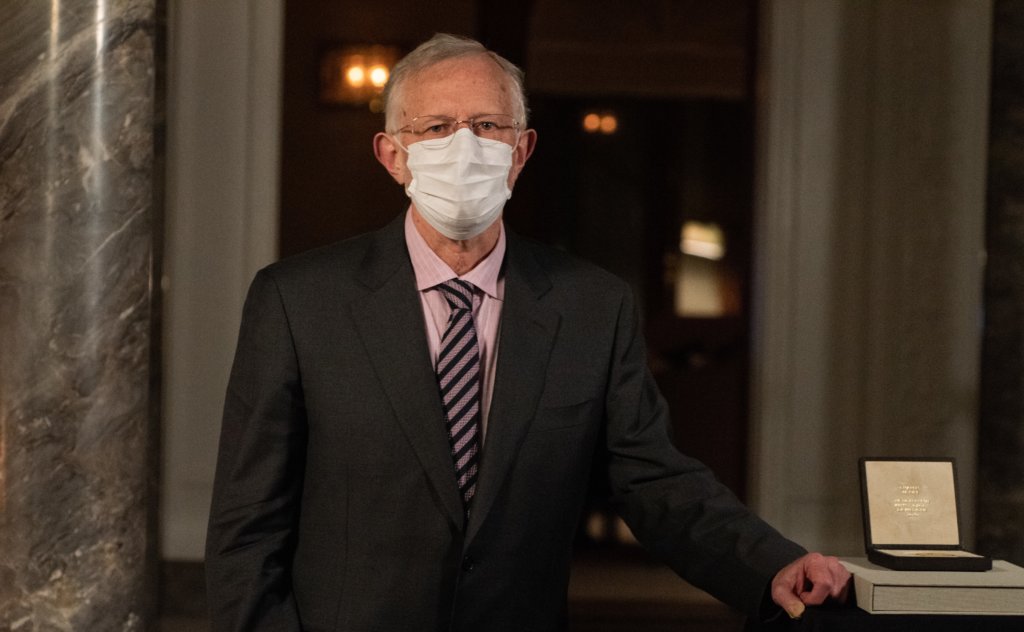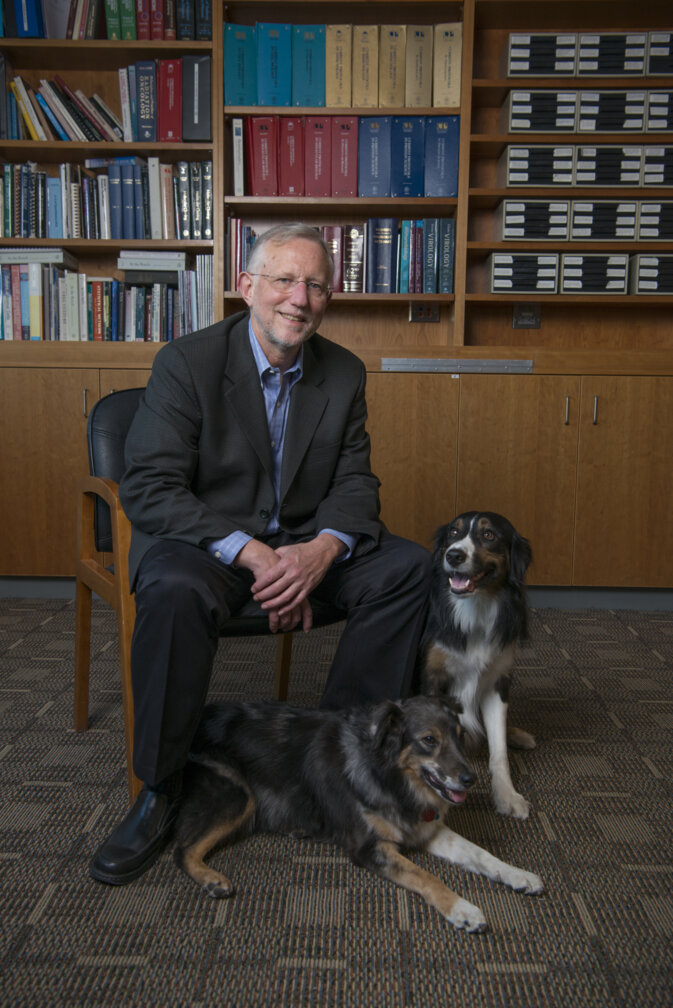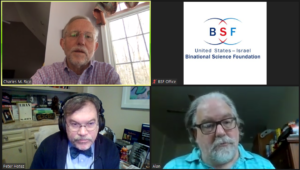
Q and A – Nobel Prize winner Dr. Charles M. Rice
Q and A with Nobel Prize winner and BSF grantee Dr. Charles M. Rice
In October, Dr. Charles M. Rice awoke to the news that he had been awarded the Nobel Prize – making him the 47th BSF grantee to become a Nobel laureate. The Rockefeller University virologist shared the prize with fellow scientists Harvey J. Alter of the National Institutes of Health and Michael Houghton of the University of Alberta.
They were honored for what the Nobel committee called “seminal discoveries” that led to the identification of the hepatitis C virus, a major global health problem that causes cirrhosis and liver cancer in people around the world.
Rice currently shares a BSF grant with Dr. Amir Shlomai of Tel Aviv University. Together, they are studying the not-yet-curable hepatitis B virus and its link to liver cancer. (See adjacent article.)
Not long after receiving his Nobel honor, Rice sat down for an engaging, wide-ranging Zoom conversation with BSF Board of Governors member Dr. Peter Hotez (himself a world-renowned virologist who is Dean for the National School of Tropical Medicine at Baylor College of Medicine) and science writer Alan Kravitz. They discussed a variety of topics, from the COVID 19 pandemic (the conversation took place in December, before vaccines became available to the public) to some of the more unusual aspects of being a Nobel winner. (Hint: Rice now gets asked to autograph photos of him and his dogs.) Here are highlights of their conversation, edited for length and clarity.
Peter Hotez: You have been honored with the Nobel Prize for your pioneering work in identifying and culturing the now-curable hepatitis C virus. With your current BSF grant, you are now part of a team focusing on the hepatitis B virus, particularly concerning that virus’ role as a leading risk factor for liver cancer. Would you mind telling us how you can take what you have learned in your hepatitis C research and apply it to this current project concerning hepatitis B?
Charles Rice: We really have switched a great deal of our emphasis now toward the hepatitis B virus. One of the things that was beneficial is that we spent a lot of time attempting to create more physiologically relevant systems for studying hepatitis C. These are viruses that infect human liver cells and these cells are notoriously finicky to work with. Once you take them out of the organ and put them in culture, they de-differentiate very quickly. We had to establish conditions to work with these cells in vitro and in humanized mouse models. We optimized reconstituting the mouse liver with a significant population of human liver cells. We’ve been able to use that technology, which was originally developed for our study of hepatitis C, to begin to bore into the biology of hepatitis B. But it was really Amir Shlomai (Rice’s BSF-funded Israeli partner) who got this whole program off the ground when he was at my lab at Rockefeller University. Amir established many of the experimental systems we still use today.
PH: So Amir is now back at Tel Aviv University and you are continuing to work together. How has that collaboration been going, working across the ocean?

CR: I think it’s going very well. What we’re interested in is trying to understand more about this enigmatic protein encoded by hepatitis B, the X protein. The other thing that has come out of this is a new way of studying hepatitis B. We found that you can initiate the entire hepatitis B virus replication cycle, not with DNA or virus, but by making a mimic of its pre-genomic RNA that encodes all the viral functions necessary to start off the virus life cycle. It allows us to begin to analyze the effects of new candidate drugs. Hepatitis B can be controlled, but it’s similar to HIV in the sense that, if you stop therapy, the virus just comes bouncing back in most people. So the emphasis now is to really try and come up with a functional cure for hepatitis B that would allow people to control the virus without being on any kind of treatment regimen.
PH: I’ve spent my life moving vaccines from discovery into clinical trials. Now we have one (for the coronavirus) going into Phase 3 finally and I realize that I just finished the easy part.
CR: We certainly saw that with hepatitis C. We’ve developed these miraculous cocktails and we’ve still got 70 million chronically infected people.
COVID-19 and coronavirus research
PH: Absolutely. Now you are applying all of your incredible virology expertise in your lab to looking at COVID 19 as well. Tell us a little bit about what you’re looking into with COVID 19 and coronaviruses.
CR: That’s been quite an experience. What we’ve been trying to do, not only with SARS-CoV-2 but also with three of the common cold-causing coronaviruses, is to try and understand more about the cellular machinery that these viruses need in order to propagate. In some work that came out in the journal Cell, we identified many particularly interesting host factors. One of these was a predicted trans membrane protein. There is not a lot known about this protein, but it was interesting because we had identified this as a protein that was required by other viruses like West Nile and Zika and yellow fever. We had tested a bunch of other virus families to see if they might also be requiring this function and they were all negative. Then, when we began expanding our work on coronaviruses, we tested that family as well and the same protein is absolutely required for replication. So, two very different virus families are dependent upon this…
PH: Just by the fact that they are RNA viruses, but that’s the only thing they have in common…
CR: We don’t really know the mechanistic basis of this at a level that we would like to. But it seems like what might be going on is that these two RNA viruses have to remodel human cell membranes to form their replication organelles. We think that this might be a common thread. Other viruses may do the same, but the kind of membrane remodeling events that are required are different…
PH: But you’re not finding these in measles virus or other coronaviruses…
CR: No. So that was kind of a fortuitous finding. We also benefited from our past studies of hepatitis C. Some years ago, we became interested in trying to understand how interferon blocked hepatitis C replication. That led to the identification of a protein called LY6E, which is a potent inhibitor of coronavirus entry. SARS-CoV-2 is a coronavirus, so when SARS-CoV-2 emerged on the horizon, we were already working on that and we showed that the same protein could inhibit entry of SARS-CoV-2. Much of what we’re doing right now has to do with gaining a better understanding of the virus-host biology and also trying to create some systems that would be useful for coronavirus studies at containment levels that aren’t necessarily at their bio-safety level 3 containment…
PH: Yeah, that would be a huge advance because donning and doffing all the PPE when going into the lab is exhausting. It really slows you down.
The importance of virology research
Alan Kravitz: Dr. Rice, what do you say to the people who think as the new COVID 19 vaccines come out, that they’ll get vaccinated and that will be it. They won’t have to deal with COVID anymore and that things can get back to normal.
CR: That’s not going to happen. But, to go from discovery of the virus to having vaccines that are going into people within one year, it’s amazing.
PH: That reminds me, I was talking to Susan Weiss, from the University of Pennsylvania, who has been working on coronaviruses. As she points out, she was working on the mouse hepatitis virus, which is a coronavirus, for years, and she was struggling to convince people why this was important. So this really is a reminder of the importance of supporting fundamental virology research.
CR: I couldn’t agree more. The coronavirus field was in danger of extinction in the 90s. There were basically just a few diehards like Susan and some labs in Europe and a few other ones in the states that kept working on the mouse hepatitis virus. While I was (a student) at Caltech, I was working on the yellow fever virus. My mom would ask, why are you working on yellow fever? We don’t really have any yellow fever in the US. But for me, it was just curiosity-driven research about this virus and this incredible vaccine that had been developed by Max Theiler in the 1930s. That work was really what put us in a position to make whatever contributions we did to the hepatitis C field when that virus was identified in 1989. It ended up being a new member of our virus family.
Life as a Nobel Prize winner
AK: Has it sunk in yet that you’re a Nobel Prize winner?
CR: I don’t know. I was initially just irritated at being woken up at 4:30 in the morning, since I’m often up late and not used to having our landline ring at that time. I didn’t expect this and I’m certainly not the type of person who’s going to be sitting by the phone waiting for the call. It’s been a strange period of time, I have to say. I guess it eventually sunk in, based on seeing the announcement on the Nobel Prize website that morning, and then the ensuing thousands of emails that have put me so far behind in terms of my correspondence that I may never dig myself out. It has been a strange time for something like this to have happened in the context of this pandemic. The festivities in Stockholm were all virtual.
PH: Hopefully, they’ll do something the following year…
CR: Yeah, they’re sort of making some noises about our ability to crash the 2021 party.
PH: That would be my recommendation.
AK: You didn’t even get to go to Sweden. You had to accept your prize at the Swedish Consul General’s residence in New York.
CR: I think the Swedes felt terrible about this situation and not being able to conduct these festivities as they have for many years. But the Consul General was fantastic. We had probably about a half dozen folks at the ceremony in a beautiful home that was built in 1910. Everybody involved had been tested the day before so at least we knew we were RNA negative 24 hours before the event. I was happy just to stay close to home. I’m having so much engagement with our work in the lab right now. I didn’t really want to take on the risk of getting infected and then being taken out of commission.
Collaboration with Israeli scientists
PH: Based on your experience collaborating with Israeli scientists, do you have any overall sense of US – Israeli scientific collaborations?
CR: I’m very bullish on this collaboration. At least for me it’s given rise to a pipeline of fantastic scientists that have come to the lab for various projects. I also have some spectacular new Israeli postdocs in the lab. I think it’s a very vibrant program. It’s certainly been wonderful for my research program and hopefully Amir feels this way.
AK When I interviewed Amir, he said that every time he goes to your lab, he learns so much not only from you, but from your whole team.
CR: I would say that I probably don’t have much to teach people anymore…
AK: I don’t know. Amir would disagree about that!
CR: It’s funny. When you think about the advances that were made in hepatitis C that took decades to accomplish and think about how quickly this could be done today, it’s a little bit embarrassing to be giving these Nobel lectures. I’m sure there’s a whole contingent of young scientists out there who are going ‘What? These guys are getting a Nobel Prize for this? We could do this in a couple days.’
PH: I remember a good part of my doctoral thesis at Rockefeller University was cloning a single gene. That was a big deal in 1984 or 1985. Now we do it in a day.
CR: I know! It’s amazing how science has advanced and I think you make a good point. A lot of the advances and technology that we have today rests on a great body of prior work. I am amazed at what these young scientists have to use.
Combatting anti- and pseudo-science
PH: The technology has become so powerful. One of the things that I’m concerned about, though, is this parallel in the aggressive rise in the anti-science. Not only the anti-vaccine movement, but what’s now become sort of an anti-science initiative or confederacy where people actively seek to discredit face masks or social distancing or create pseudo-science around fake concepts of herd immunity. I’m sure you’ve witnessed this as well and it’s not only in the US. It’s moving to Europe now and even possibly Israel. Any thoughts about that?
CR: Well, it’s certainly very worrying. If you asked me about this when I was starting off as a graduate student, that we would be in this space right now, it’s almost unimaginable. But I think we really have to try and establish communication, at least with those who are willing to have a dialogue.
PH: There are not many silver linings to this pandemic, but one of the things that I’ve noticed is that people on the cable news networks like hearing from scientists – not necessarily filtered through journalists and anchors. People are now hearing directly from scientists for the first time and they generally like what they’re hearing. They like the fact that they’re not being spoken to like they’re in the fourth grade or the sixth grade. They actually appreciate some of the complexity, so I think that’s very gratifying.
CR: Yeah. I agree.
Work-life balance: “What is that?”
AK: I wanted to ask you one more question that deals with work-life balance.
CH: What’s that?
AK: Well, that may be the answer, but Nobel laureates in particular, often have this aura that work is their whole existence. What can you share about your work-life balance and what advice might you have for early career scientists in this regard?

CR: Well, since my passion is science, there are relatively few things I’d rather be doing beside being in the lab doing the bench work, or hounding the people doing the bench work. But I do think you need some time away from your work passion. I have a real love of the outdoors. Hiking and backpacking are something that we (with his spouse, Dr. Peggy MacDonald, an infectious disease researcher at Rockefeller) still try and do. Once a year, we like to get out of New York City and get to an extremely remote spot in the Wyoming Wind River Range. We’ve also had a very dedicated canine support group. I very much enjoy getting outside and and playing with the dogs. There’s a picture of me with two of our Australian shepherds on the Nobel Prize website. One of the bizarre things that happens when one gets one of these prizes is that you also get this stampede of people who want you to sign photographs. In some cases, they’ve been proactive enough to send the photograph and several of them want me to sign the picture with the dogs. It seems to be quite a favorite.
AK: Do you have any other passions?
CR: Yes. Wine. This was a side effect of my undergraduate training at UC Davis. That school is particularly well known for its viticulture and enology program, e.g., grape growing and wine making. I took an introductory course and I became interested in that. There was a time when I was teetering between going to graduate school on a research trajectory, versus just going off, getting more training and becoming a wine maker. I haven’t done that, but I do still have an interest in wine. I’ve been enjoying some very nice ones from Israel.

